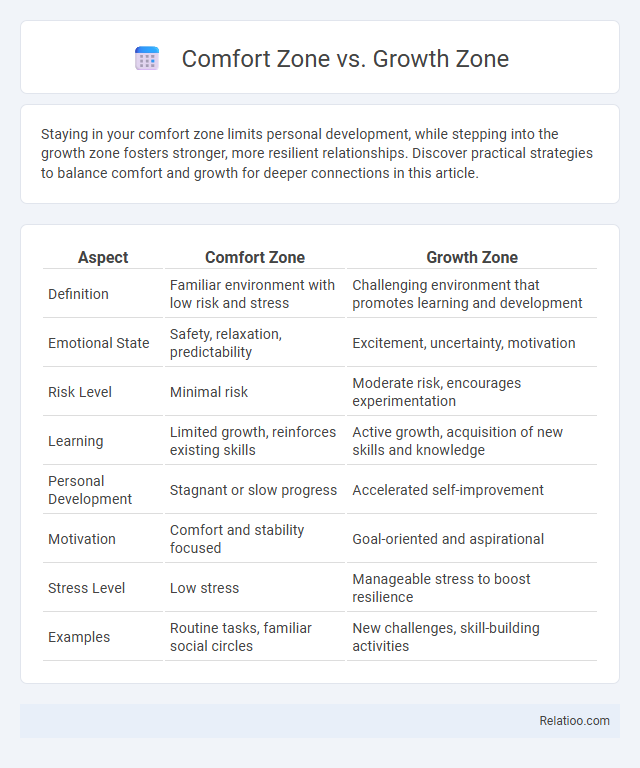Staying in your comfort zone limits personal development, while stepping into the growth zone fosters stronger, more resilient relationships. Discover practical strategies to balance comfort and growth for deeper connections in this article.
Table of Comparison
| Aspect | Comfort Zone | Growth Zone |
|---|---|---|
| Definition | Familiar environment with low risk and stress | Challenging environment that promotes learning and development |
| Emotional State | Safety, relaxation, predictability | Excitement, uncertainty, motivation |
| Risk Level | Minimal risk | Moderate risk, encourages experimentation |
| Learning | Limited growth, reinforces existing skills | Active growth, acquisition of new skills and knowledge |
| Personal Development | Stagnant or slow progress | Accelerated self-improvement |
| Motivation | Comfort and stability focused | Goal-oriented and aspirational |
| Stress Level | Low stress | Manageable stress to boost resilience |
| Examples | Routine tasks, familiar social circles | New challenges, skill-building activities |
Understanding the Comfort Zone
The comfort zone represents a psychological state where individuals experience low stress and high familiarity, enabling routine behaviors without significant challenges or risk. This zone lacks stimuli for personal development, often leading to stagnation in skills and mindset as the brain minimizes exposure to unfamiliar experiences. Recognizing the boundaries of the comfort zone is essential for fostering growth, as stepping beyond it into the growth zone triggers adaptive learning and resilience.
Defining the Growth Zone
The Growth Zone represents the space where individuals face challenges and embrace new experiences that promote learning, skill development, and personal expansion. Unlike the Comfort Zone, which is characterized by routine and minimal stress, the Growth Zone encourages stepping beyond familiar boundaries to build resilience and adaptability. Staying within the Growth Zone fosters continuous improvement and unlocks potential that remains dormant in the Comfort Zone.
Key Differences Between Comfort and Growth Zones
The comfort zone is characterized by routine, low stress, and minimal risk, providing a sense of safety but limited personal development. In contrast, the growth zone involves challenges, learning opportunities, and moderate stress that promote skill enhancement and self-improvement. Key differences include risk tolerance, emotional state, and outcomes: the comfort zone fosters stability, while the growth zone drives progress and resilience.
Psychological Barriers to Leaving the Comfort Zone
Psychological barriers to leaving the comfort zone include fear of failure, uncertainty, and self-doubt, which create resistance to entering the growth zone where learning and development occur. The comfort zone offers predictability and emotional safety, making individuals reluctant to face the discomfort and challenges necessary for personal growth. Overcoming these mental blocks requires cognitive restructuring and resilience to embrace new experiences beyond familiar routines.
Benefits of Embracing the Growth Zone
Embracing the Growth Zone fosters resilience, creativity, and continuous self-improvement by challenging individuals to step beyond familiar Comfort Zone boundaries. Exposure to new experiences in the Growth Zone enhances problem-solving skills and adaptability, crucial for personal and professional development. Regular engagement with growth opportunities accelerates skill acquisition and boosts confidence, driving long-term success and fulfillment.
Common Misconceptions About Comfort Zones
Many believe the comfort zone is strictly a place of stagnation, yet it provides essential stability and mental rest necessary for productivity. Your growth zone involves challenges that promote development but can also induce stress if pushed too far, leading to the panic zone where learning becomes counterproductive. Misconceptions arise when people think growth means constant discomfort, ignoring that balanced transitions between comfort and growth zones foster sustainable personal and professional advancement.
Signs You’re Stuck in Your Comfort Zone
Feeling a lack of motivation, repetitive daily routines, and avoidance of challenges are clear signs you're stuck in your comfort zone. This state limits personal development by fostering complacency and resistance to change. Recognizing these signs is crucial to transition into the growth zone, where embracing challenges stimulates learning and self-improvement.
Strategies to Transition Into the Growth Zone
To transition from your Comfort Zone to the Growth Zone, implement strategies such as setting specific, challenging goals that push your limits while maintaining manageable risks. Gradually expose yourself to new experiences that build resilience and adaptability, reinforcing positive habits through consistent practice and reflection. Seeking feedback and support from mentors or peers accelerates learning and helps you stay accountable as you expand your capabilities.
Real-Life Examples of Growth Beyond Comfort
Your personal growth often happens when you step outside the Comfort Zone, where routine and safety dominate, into the Growth Zone, where challenges and learning opportunities exist. For example, an employee who volunteers for a leadership role outside their comfort level may experience increased confidence and skill development, demonstrating real-life growth beyond comfort. Similarly, someone who takes on a new hobby like public speaking or fitness training breaks old patterns and expands their abilities.
Maintaining Momentum After Leaving Your Comfort Zone
Maintaining momentum after leaving your comfort zone requires embracing the growth zone, where challenges stimulate personal development and resilience. Your focus should be on consistent goal-setting and positive reinforcement to sustain progress and avoid slipping back into the comfort zone. Building habits that align with new skills and experiences ensures long-term adaptation and continuous improvement.

Infographic: Comfort Zone vs Growth Zone
 relatioo.com
relatioo.com